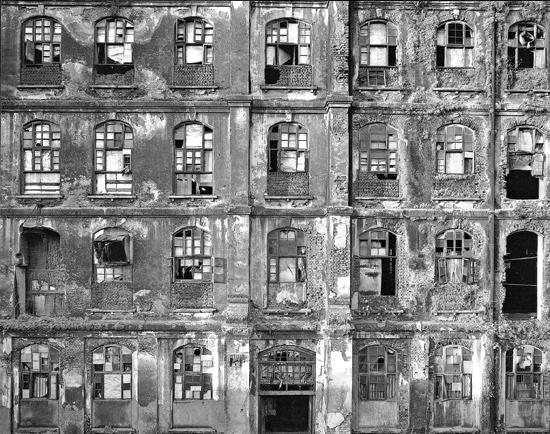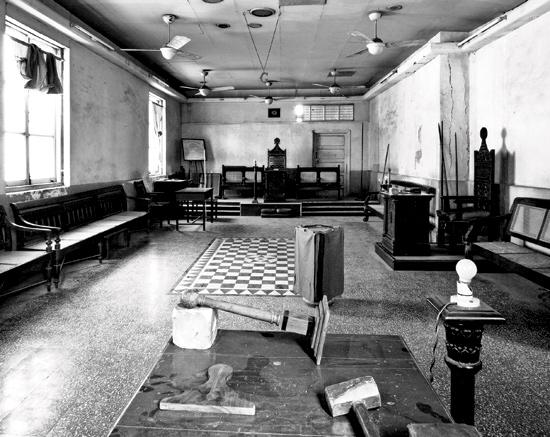Time seems to have stood still in Christopher Taylor’s iconic black and white frames that celebrate structures in imperial Bombay and Calcutta, each a silent bystander of an invaluable past

Christopher Taylor, photo exhibition, Institutions, black-and-white frames, Old Bombay, Old Calcutta, Mumbai, Kolkata, United Cotton Mill no. 1, Parel, Bombay, Freemason�s Hall, Kenesseth Eliyahoo Synagogue, Kala Ghoda, Lawyers Archives, Royal Insura
Q. Your work showcases imperial Calcutta and Bombay in a new light; what kind of background research did you have to undertake before beginning your photography?
A. The The idea to photograph the buildings of Calcutta and Bombay came quite suddenly at the end of 2002, and I left France to start the project soon afterwards, having acquired a second-hand view camera. I had already spent time in both cities, particularly Calcutta, during previous visits to India from as early as 1986, and this experience was valuable. 
United Cotton Mill no. 1, Parel, Bombay, 2005. PIC COURTESY/ ©Christopher Taylor / Courtesy Tasveer/ Vacheron Constantin and The Singleton of Glen Ord
ADVERTISEMENT
The real research was made when I started the project in January 2003. I walked endlessly around the city looking for suitable locations, and also made many enquiries meeting people like G M Kapur at INTACH in Calcutta, the conservation architect Manish Chakraborty, the city corporation and so on. These people put me in touch with others and gradually I gained access to the places, which interested me.

Freemason’s Hall, Bombay, 2004;
A lot of leg work was involved, and patience, writing letters, making appointments to meet officials to get the necessary written authorisation to visit premises outside of office hours when the buildings would be empty of people; but I found that nearly everyone I met was helpful and courteous if approached in the correct manner.

Kenesseth Eliyahoo Synagogue, Kala Ghoda, Bombay, 2004. all pics courtesy/ ©Christopher Taylor / Courtesy Tasveer/ Vacheron Constantin and The Singleton of Glen Ord
In fact this aspect of the project became an enriching experience and I met many interesting people. A small exhibition of the earliest photographs at the British Council In Calcutta and Kala Ghoda arts festival in Bombay in 2005 led to more contacts, in particular the journalist Soumitra Das with whom I later collaborated for a book. Soumitra-s intimate knowledge of Calcutta was invaluable.

Lawyer-s Archives, Calcutta, 2006
Q.Despite reliving the past there is a certain grandeur that comes across in every frame; how were you able to do this?
A. The spaces were often impressive and I wanted to replicate somehow that impression. It was important to have everything sharp to render all the detail visible, and for this purpose I used a view camera mounted on a tripod and 4 x 5 inch sheet film, for good detail and control of perspective.
Also I wanted to use natural light whenever possible, or otherwise the existing artificial light. Sometimes this was successful, sometimes not and I made many mistakes, but this slow way of working also builds a relationship with the space, and perhaps this sometimes comes across in the images.
I enjoyed very much the process, first to have access a privilege in itself, then to explore the space often alone, and absorb the atmosphere before deciding where to take the photographs: usually exposing just 10 or 12 negatives in a day. Each photograph is carefully considered. In dimly lit rooms the exposure time was sometimes 30 mins. Time to open the shutter, go away to have a cup of tea, and then come back and close the shutter. This was pleasurable!

Royal Insurance Building, BBD Bagh, Calcutta, 2006
Q. Tell us a bit about why you chose this subject; what was the trigger point?
A. The cities of Calcutta and Mumbai fascinated me from previous visits to India, perhaps because of certain similarities to London. So much was going on, everywhere something to see, somewhat overwhelming. I had attempted other things before this project, a series of close-up portraits of people I met in the street for instance, but they did not seem to convey what I was looking for. I had not photographed buildings before, and architecture is not something that really interests me, but these buildings were also a bridge to the past, which sometimes seemed frozen inside. So I decided to buy the appropriate equipment to represent this.
The project is not about nostalgia, quite the opposite in fact, even if these spaces are sometimes beautiful, but it seemed a way of understanding history, or at least that colonial era which has had so many repercussions. If nostalgia seems apparent, I think it comes from those who inhabit or who had worked in the spaces. There are paradoxes, which are sometimes hard to fathom, and this fed my fascination as the project evolved.
Q. How did you zero in on the subjects; for example industrial Bombay has so many elements due to its standing as the premier centre of commerce even before the days of the Raj...
First I looked for administrative centres, then religious, clubs and residential buildings which were easier to access, then commercial and industrial more complicated to get authorisation to photograph. The initial idea was to concentrate on the colonial aspect, of which examples are represented in the "Institutions" exhibition, but the project also evolved to encompass other aspects of the built heritage.
Over 10 years I have built a sort of archive particularly since embarking on collaborative books and the images shown here are a certain selection; but getting back to the initial idea, I had decided that I needed to have photographs which represented buildings of a variety of function, including industrial, in particular the textile industry - cotton and jute - which was so important economically during the Raj. The old textile factories were enormous and disappearing, so it seemed important to document them. Perhaps in some ways they reminded me of the old textile mills of Britain, for which my grandfather worked as a manager of dyes. I still remember the sirens which indicated the change of shift twice a day in the factories when I stayed at my grandfather-s house.
 Subscribe today by clicking the link and stay updated with the latest news!" Click here!
Subscribe today by clicking the link and stay updated with the latest news!" Click here!






